2020-04-09 - Nº 258
Editorial
Esta é a Newsletter Nº 258 que se apresenta com o mesmo formato que as anteriores. Se gostar da Newsletter partilhe-a!
Todas as Newsletters encontram-se indexadas no link.
Esta Newsletter tem os seguintes tópicos:
....
Faz hoje anos que nascia, em 1770, o físico alemão Thomas Johann Seebeck. Ele descobriu (1821) que uma corrente eléctrica flui entre diferentes materiais condutores que são mantidos em diferentes temperaturas, conhecido como efeito Seebeck. É a base do termopar e é considerada a medição mais precisa da temperatura. É também um componente-chave do semicondutor, a base do moderno computador. O trabalho de Seebeck foi a base das descobertas do físico alemão Georg Simon Ohm (1789-1854) em electricidade e do físico francês Jean Charles Athanase Peltier (1785-1845), cujo efeito Peltier ficou conhecido como uma maneira de usar a electricidade para congelar a água (ar condicionado, refrigeração).
Faz também hoje anos que nascia, em 1791, o matemático inglês George Peacock. Ele, juntamente com os colegas de graduação Charles Babbage e John Herschel, trouxe reformas à nomenclatura na matemática inglesa. Eles formaram a Analytical Society (1815), cujo objectivo era levar os métodos avançados de cálculo da Europa para Cambridge para substituir a notação cada vez mais estagnada de Isaac Newton do século anterior. A Sociedade produziu uma tradução de um livro de Lacroix no cálculo diferencial e integral. Em 1830, ele publicou o Tratado sobre Álgebra, que tentou dar à álgebra um tratamento lógico, e que foi pelo menos parcialmente para o estabelecimento da álgebra simbólica. Em vez de usar apenas números, ele usou objectos e mostrou a associatividade e a comutatividade desses objectos.
Faz igualmente hoje anos que nascia, em 1864, o engenheiro electrotécnico inglês Sebastian Ziani de Ferranti. Ele promoveu a instalação de grandes estações geradoras eléctricas e redes de distribuição de corrente alternada na Inglaterra. Com cerca de 20 anos, ele começou a planear uma estação geradora ambiciosa a cerca de 13 quilómetros dos arredores de Londres, para usar a transmissão a 10.000 volts - quatro vezes maior do que era prático anteriormente. Para isso, ele começou a projectar cabos, transformadores e geradores adequados. A sua ideia de fabricar cabos flexíveis de alta tensão usando papel impregnado com cera para isolamento foi um marco histórico usado exclusivamente até ao advento de materiais sintéticos. As suas 176 patentes cobrem diversas invenções.
Faz também hoje anos que nascia, em 1865, o engenheiro electrotécnico e inventor de origem alemã Charles Proteus Steinmetz. As suas teorias e análises matemáticas dos sistemas de corrente alternada ajudaram a estabelecê-los como a forma preferida de energia eléctrica nos Estados Unidos e em todo o mundo. Em 1893, Steinmetz entrou para a recém-criada General Electric Company, onde era engenheiro e depois consultor até sua morte. As suas primeiras pesquisas sobre histerese (perda de potência devido à resistência magnética) levaram-o a estudar a corrente alternada, o que poderia eliminar a perda de histerese nos motores. Ele fez um extenso trabalho sobre a teoria de AC para engenheiros electrotécnicos usarem. A sua última pesquisa foi sobre relâmpagos e a sua ameaça para as novas linhas de energia AC. Ele foi responsável pela expansão da indústria de energia eléctrica nos EUA.
Faz igualmente hoje anos que nascia, em 1869, o matemático francês Élie Cartan. Ele desenvolveu muito a teoria dos grupos de Lie e contribuiu para a teoria das subalgebras. Em 1904, Cartan voltou-se para artigos sobre equações diferenciais e, a partir de 1916, publicou principalmente sobre geometria diferencial. Cartan também publicou trabalhos sobre a relatividade e a teoria dos spinors. Ele é certamente um dos matemáticos mais importantes da primeira metade do século XX.
Faz também hoje anos que nascia, em 1899, o Fabricante americano de aeronaves James Smith McDonnell. Ele iniciou a sua primeira empresa em 1928, para construir o Doodlebug único, mas como não encontrou mercado, passou os próximos 10 anos a trabalhar em várias empresas de aeronaves. Posteriormente, ele fundou a McDonnell Aircraft Co.on, em St. Louis, em 6 de Julho de 1939. Entre suas realizações notáveis, figuram a produção do primeiro caça a jacto da Marinha dos EUA (1946), o FM-1; Mercury, a primeira nave espacial tripulada da América a orbitar a Terra (1962) e o jacto F-4 Phantom.
Por fim, faz hoje anos que nascia, em 1919, o engenheiro e inventor americano J. Presper Eckert. Ele foi o inventor do primeiro computador electrónico de uso geral, uma máquina digital que foi o protótipo para a maioria dos computadores actualmente em uso. Em 1946, Eckert com John W. Mauchly cumpriu um contrato do governo para construir um computador digital para ser usado pelo Exército dos EUA para cálculos militares. Eles chamaram-o de ENIAC para Integrador Numérico Electrónico e Computador. Em 1949, eles fundaram uma empresa de fabricação de computadores BINAC. Isso foi seguido por um computador voltado para os negócios, o UNIVAC (1951), que foi utilizado para muitos usos e estimulou o crescimento da indústria de computadores. Em 1966, Eckert possuía 85 patentes, principalmente para invenções electrónicas.
Na Newsletter desta semana apresentamos diversos artigos científicos assim como projetos de maker. É apresentada a revista HispaBrick 34.
 João Alves ([email protected])
João Alves ([email protected])
O conteúdo da Newsletter encontra-se sob a licença  Creative Commons Attribution-NonCommercial-ShareAlike 4.0 International License.
Creative Commons Attribution-NonCommercial-ShareAlike 4.0 International License.
Outras Notícias

CircuitPython 5.2.0 Released!
"5.2.0 This is CircuitPython 5.2.0, it features a new port to LiteX, a Python powered hardware description system used to define a soft System on Chip (SoC) that is then loaded into a Field Programmable Gate Array (FPGA). There are a few minor fixes and improvements over 5.1.0 as well. Download from circuitpython.org Downloads are available from circuitpython.org! The site makes it easy to select the correct file and language for your board. The downloads page is here. Downloads are no longer available from the GitHub release pages because of the large number of files for each release." [...]

Maxim Integrated’s Next-Generation SIMO Power Management IC Cuts Solution Size by Half and Extends Battery Life by 20 Percent for Wearables and Hearables
"Breakthrough SIMO technology replaces traditional power management architectures, reducing BOM count by up to 40 percent for compact consumer devices Designers of compact consumer devices can now slash solution size by half and extend battery life by 20 percent with the MAX77654 single inductor, multiple output (SIMO) power management IC (PMIC) from Maxim Integrated Products, Inc. (NASDAQ: MXIM). This next-generation SIMO PMIC delivers 3 outputs with just one inductor at 91 percent efficiency, which is 16 percent greater than traditional 4-chip systems. With significantly reduced solution size, system designers can pack more functionality in their applications such as wearables, hearables and other compact consumer devices when compared to using traditional power solutions. The MAX77654 builds on Maxim Integrated's robust portfolio of SIMO PMICs. Maxim Integrated's SIMO solutions › MAX77654 › Hi-Resolution Image › As designers continue their quest to shrink form factors for compact consumer devices, they must also consider extending battery life (or shrinking battery volume), as well as reducing heat dissipation and noise. The MAX77654 SIMO PMIC addresses space-constraint challenges for system designers by replacing 3 buck-boost converters, 3 inductors with a single converter and a single inductor." [...]

NXP’s New Wi-Fi 6 Portfolio Accelerates its Large-Scale Adoption Across IoT, Auto, Access and Industrial Markets
"NXP Semiconductors N.V. (NASDAQ: NXPI), today announced the availability of a comprehensive Wi-Fi 6 (802.11ax) portfolio, which significantly expands the number of products and markets able to adopt the latest Wi-Fi standards. NXP’s expanded Wi-Fi 6 portfolio represents the company’s new end-to-end vision and differentiated technology approach that is designed to help usher in an era of connectivity innovation for automotive, access, mobile and Industrial and IoT markets. Wi-Fi 6 delivers a wealth of additional connectivity improvements, including symmetric multi-gigabit uploads and downloads, dramatically lower latency, increased capacity, and improved power efficiency across applications. These technical advancements have so far been limited to premium products. With NXP’s broad portfolio, these benefits are now available for large-scale deployment across multiple markets, enabling products with today’s most advanced Wi-Fi capabilities, including: Up to 4x performance improvement Greater range Improved battery life Greater connection reliability “To deliver Wi-Fi 6 to broader markets, OEMs need Wi-Fi 6 options that scale to their needs. They need a family of products that matches the performance and cost needs of their different market segments,” said Rafael Sotomayor, senior vice president of Security and Connectivity at NXP." [...]
Ciência e Tecnologia

Scientists tap unused energy source to power smart sensor networks
"The electricity that lights our homes and powers our appliances also creates small magnetic fields that are present all around us. Scientists have developed a new mechanism capable of harvesting this wasted magnetic field energy and converting it into enough electricity to power next-generation sensor networks for smart buildings and factories. “Just like sunlight is a free source of energy we try to harvest, so are magnetic fields,” said Shashank Priya, professor of materials science and engineering and associate vice president for research at Penn State. “We have this ubiquitous energy present in our homes, office spaces, work spaces and cars. It’s everywhere, and we have an opportunity to harvest this background noise and convert it to useable electricity.” A team led by Penn State scientists developed a device that provides 400 percent higher power output compared to other state-of-the-art technology when working with low-level magnetic fields, like those found in our homes and buildings. The technology has implications for the design of smart buildings, which will require self-powered wireless sensor networks to do things like monitor energy and operational patterns and remotely control systems, the scientists said." [...]

Quantum-entangled light from a vibrating membrane
"Entanglement, a powerful form of correlation among quantum systems, is an important resource for quantum computing. Researchers from the Quantum Optomechanics group at the Niels Bohr Institute, University of Copenhagen, recently entangled two laser beams through bouncing them off the same mechanical resonator, a tensioned membrane. This provides a novel way of entangling disparate electromagnetic fields, from microwave radiation to optical beams. In particular, creating entanglement between optical and microwave fields would be a key step towards solving the long-standing challenge of sharing entanglement between two distant quantum computers operating in the microwave regime. The result is now published in Nature Communications. In a future quantum internet, that is the internet of quantum computers, entanglement needs to be shared between two distant quantum computers." [...]

Graphene-based actuator swarm enables programmable deformation
"Actuators that can convert various environmental stimuli to mechanical works have revealed great potential for developing smart devices such as soft robots, micro-electromechanical systems (MEMS), and automatic Lab-on-a-Chip systems. Generally, bilayer structures are widely used for design and fabrication of stimuli responsive actuators. In the past decade, to pursue fast and large-scale deformation, great efforts have been devoted to the development of novel smart materials. To date, various stimuli response materials/structures have been successfully developed and employed for bimorph actuators. Recently, graphene and graphene oxide (GO) that possess a series of outstanding physical/chemical properties have emerged as a new type of smart material for actuator design. Various graphene-based bimorph actuators have been successfully reported." [...]

New Images Reveal Fine Threads Of Million-degree Plasma Woven Throughout The Sun’s Atmosphere
"Researchers at the University of Central Lancashire (UCLan) unveil highest-ever resolution images of the Sun from NASA’s solar sounding rocket mission Newly released images of the Sun have revealed that its outer layer is filled with previously unseen, incredibly fine magnetic threads filled with extremely hot, million-degree plasma. The high-resolution observations have been analysed by researchers at UCLan alongside collaborators from NASA’s Marshall Space Flight Centre (MSFC) and will provide astronomers with a better understanding of how the Sun’s magnetised atmosphere exists, and what it is comprised of. Until now, certain parts of the Sun’s atmosphere had appeared dark or mostly empty, but new images have revealed strands that are around 500km in width - roughly the distance between London and Belfast - with hot electrified gases flowing inside them. The ultra-sharp images were taken by NASA’s High-Resolution Coronal Imager (or Hi-C for short), a unique astronomical telescope carried into space on a sub-orbital rocket flight. The telescope can pick out structures in the Sun’s atmosphere as small as 70km in size, or around 0.01% the size of the Sun, making these the highest resolution images ever taken of the Sun’s atmosphere. The exact physical mechanism that is creating these pervasive hot strands remains unclear, so scientific debate will now focus on why they are formed, and how their presence helps us understand the eruption of solar flares and solar storms that could affect life on Earth." [...]

Sprayable user interfaces
"CSAIL's SprayableTech system lets users create large-scale interactive surfaces with sensors and displays using airbrushed inks. For decades researchers have envisioned a world where digital user interfaces are seamlessly integrated with the physical environment, until the two are virtually indistinguishable from one another. This vision, though, is held up by a few boundaries. First, it’s difficult to integrate sensors and display elements into our tangible world due to various design constraints. Second, most methods to do so are limited to smaller scales, bound by the size of the fabricating device. Recently, a group of researchers from MIT’s Computer Science and Artificial Intelligence Laboratory (CSAIL) came up with SprayableTech, a system that lets users create room-sized interactive surfaces with sensors and displays." [...]
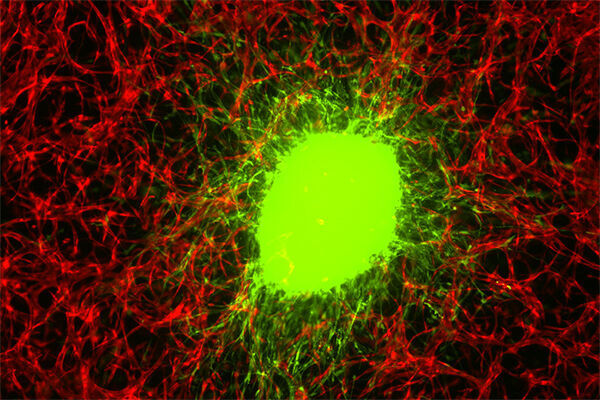
A 3d-printed Brain Could Make It Easier To Find Cancer Treatments
"Glioblastoma is the deadliest form of brain tumor—less than 10 percent of people who are diagnosed with it will survive more than five years. A group of researchers has devised a new way to study this rapidly spreading cancer, using a three-dimensional structure made of an agglomeration of human brain cells and biomaterials. Their work, published in Science Advances, could help medical professionals better understand how the tumor grows and to speed up the potential discovery of new drugs to fight it. “This is a very difficult brain tumor to treat,” says Guohao Dai, an associate professor of bioengineering at Northeastern and corresponding author on the study. “And it’s also difficult to do research on the brain tumor, because you cannot really see what’s happening.” Inside a living brain, researchers can’t directly observe how tumor cells grow and respond to treatment. Studies are typically done in mice or rats, and the animals must be dissected to understand the tumor’s development." [...]
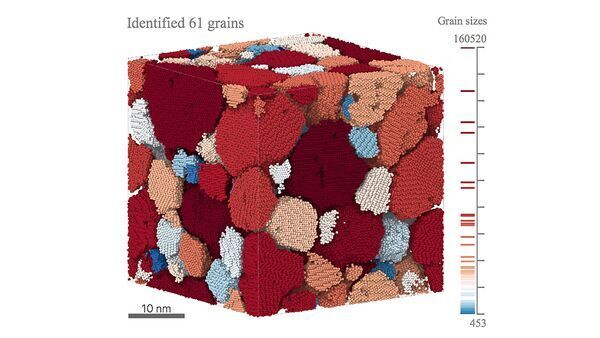
Capturing 3D microstructures in real time
"Machine-learning based algorithm characterizes 3D material microstructure in real time Modern scientific research on materials relies heavily on exploring their behavior at the atomic and molecular scales. For that reason, scientists are constantly on the hunt for new and improved methods for data gathering and analysis of materials at those scales. Researchers at the Center for Nanoscale Materials (CNM), a U.S. Department of Energy (DOE) Office of Science User Facility located at the DOE’s Argonne National Laboratory, have invented a machine-learning based algorithm for quantitatively characterizing, in three dimensions, materials with features as small as nanometers. Researchers can apply this pivotal discovery to the analysis of most structural materials of interest to industry. “What makes our algorithm unique is that if you start with a material for which you know essentially nothing about the microstructure, it will, within seconds, tell the user the exact microstructure in all three dimensions,” said Subramanian Sankaranarayanan, group leader of the CNM theory and modeling group and an associate professor in the Department of Mechanical and Industrial Engineering at the University of Illinois at Chicago. “For example, with data analyzed by our 3D tool,” said Henry Chan, CNM postdoctoral researcher and lead author of the study, “users can detect faults and cracks and potentially predict the lifetimes under different stresses and strains for all kinds of structural materials.” “What makes our algorithm unique is that if you start with a material for which you know essentially nothing about the microstructure, it will, within seconds, tell the user the exact microstructure in all three dimensions.” — Subramanian Sankaranarayanan, CNM group leader and associate professor at the University of Illinois at Chicago Most structural materials are polycrystalline, meaning a sample used for purposes of analysis can contain millions of grains." [...]
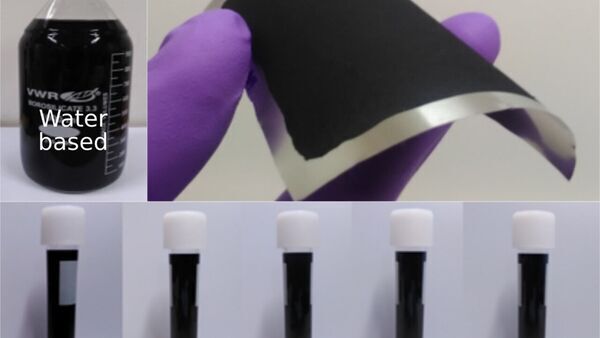
Physicists produce stable water-based graphene dispersions
"Umeå researchers show how activated graphene, activated carbons and other hydrophobic carbons can be dispersed in water in a form of micrometer-sized particles. The key agent that helps to make these dispersions last for days is the oxidized form of graphene named graphene oxide. The authors have applied for patent for the method to prepare dispersions. Graphene, graphite, activated carbons are quite different forms of carbon but what is common for them is their hydrophobic properties. It is impossible to dissolve or disperse these materials in water directly. On the other hand, using dispersions or solutions for many applications is a big advantage." [...]

Purdue researchers 3D-print minerals in order to better predict fracture formation
"Cracks are everywhere, and they often mean trouble. In the foundation of your house, in your windshield, in the tectonic plates below your feet. But, surprisingly, scientists don’t actually understand them as well as they would like. Purdue physics professor Laura Pyrak-Nolte and her lab team works with Purdue’s Rock Physics Research Group to better understand how and where fractures form. Being able to predict and understand fractures is vitally important to a wide range of fields, including improving the safety and efficacy of natural gas production, carbon sequestration, and nuclear waste disposal. It’s also important in improving the structural integrity of large 3D-printed components, including bridges and human habitats on other planets." [...]

Thanks to “flexoskeletons,” these insect-inspired robots are faster and cheaper to make
"Engineers at the University of California San Diego have developed a new method that doesn’t require any special equipment and works in just minutes to create soft, flexible, 3D-printed robots. The innovation comes from rethinking the way soft robots are built: instead of figuring out how to add soft materials to a rigid robot body, the UC San Diego researchers started with a soft body and added rigid features to key components. The structures were inspired by insect exoskeletons, which have both soft and rigid parts—the researchers called their creations “flexoskeletons.” The new method allows for the construction of soft components for robots in a small fraction of the time previously needed and for a small fraction of the cost. “We hope that these flexoskeletons will lead to the creation of a new class of soft, bioinspired robots,” said Nick Gravish, a mechanical engineering professor at the Jacobs School of Engineering at UC San Diego and the paper’s senior author. “We want to make soft robots easier to build for researchers all over the world.” The new method makes it possible to build large groups of flexoskeleton robots with little manual assembly as well as assemble a library of Lego-like components so that robot parts can be easily swapped. The flexoskeletons are made from 3D printing a rigid material on a thin sheet that acts as a flexible base." [...]
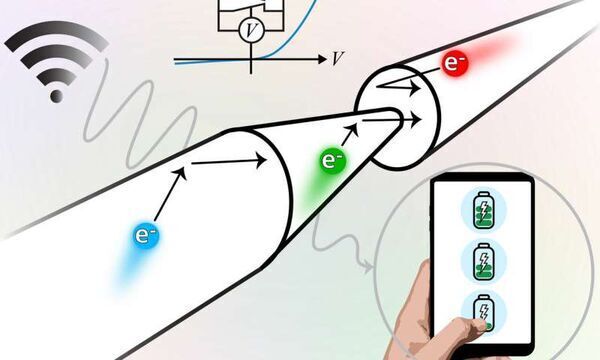
UNC-Chapel Hill researchers develop one-way street for electrons
"Research may unlock the ability for devices to process ultra-high-speed wireless data and simultaneously harvest energy for power. Researchers at the University of North Carolina at Chapel Hill made a one-way street for electrons that may unlock the ability for devices to process ultra-high-speed wireless data and simultaneously harvest energy for power. The researchers did this by shaping silicon on a microscopic scale to create a funnel, or “ratchet,” for electrons. This method overcomes the speed limitations of prior technologies by removing interfaces that tend to slow down devices.“This work is exciting because it could enable a future where things like low-power smartwatches are wirelessly charged from the data they already receive without ever needing to a leave a person’s wrist,” said James Custer Jr., a doctoral student in UNC-Chapel Hill’s College of Arts & Sciences. The findings were published April 10 in the journal Science. Custer is lead author." [...]
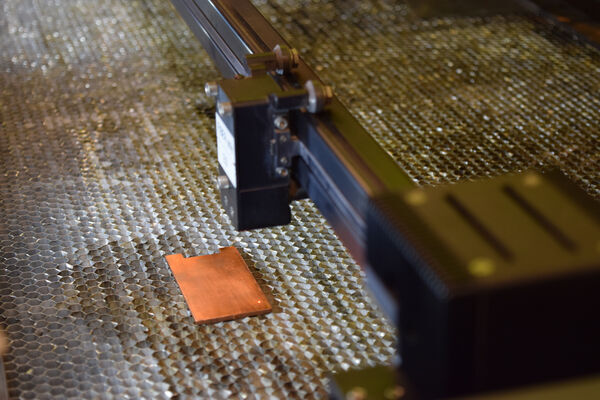
Now metal surfaces can be instant bacteria killers, thanks to new laser treatment technique
"Bacterial pathogens can live on surfaces for days. What if frequently touched surfaces such as doorknobs could instantly kill them off? Purdue University engineers have created a laser treatment method that could potentially turn any metal surface into a rapid bacteria killer – just by giving the metal’s surface a different texture. In a study published in the journal Advanced Materials Interfaces, the researchers demonstrated that this technique allows the surface of copper to immediately kill off superbugs such as MRSA. “Copper has been used as an antimicrobial material for centuries. But it typically takes hours for native copper surfaces to kill off bacteria,” said Rahim Rahimi, a Purdue assistant professor of materials engineering." [...]
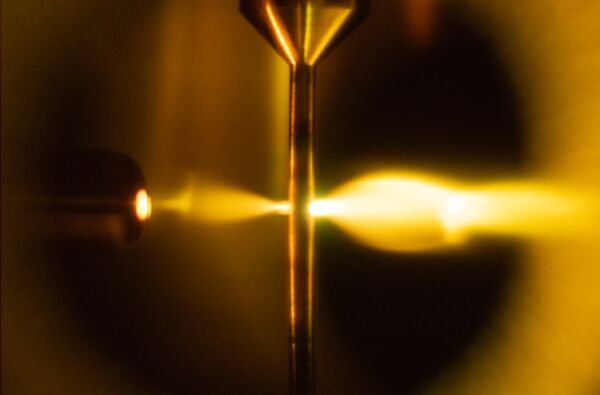
X-ray vision through the water window
"ETH physicists have developed the first high-repetition-rate laser source that produces coherent soft x-rays spanning the entire ‘water window’. That technological breakthrough should enable a broad range of studies in the biological, chemical and material sciences as well as in physics. The ability to generate light pulses of sub-femtosecond duration, first demonstrated some 20 years ago, has given rise to an entirely new field: attosecond science and technology. Table-top laser systems have emerged that enable studies that for decades were but a distant dream — to follow, image and characterise electronic processes in atoms, molecules and solids on their natural, attosecond timescales. The laser systems that make such studies possible typically operate in the extreme ultraviolet spectral band. There has long been a push to achieve higher photon energies though." [...]
Documentação
A documentação é parte essencial do processo de aprendizagem e a Internet além de artigos interessantes de explorar também tem alguma documentação em formato PDF interessante de ler. Todos os links aqui apresentados são para conteúdo disponibilizado livremente pelo editor do livro.

Hispabrick Magazine Issue 34
"Hispabrick is a LEGO magazine that’s published both in English and Spanish and available for free in digital format and also in print (at cost) for the past 12 years. The first issue for 2020 is now available after a short delay as Lluís Gibert from the editorial board had a new addition to his family! Congrats and we welcome a BFOD (Baby Fan Of Duplo) to the community. This issue covers the Star Wars Boost Droid Orchestra behind the scenes, a virtual tour of the LEGO Store in Shanghai, EV3 Programming tutorial and much more. If you are new to the LEGO scene or missed any of the previous issues, they’re always available for download. " [...]
Projetos Maker
Diversos Projetos interessantes.

Mesmerizing Magnetic Wall Clock
"Mechanical clocks have always fascinated me. The way all of the internal gears, springs, and escapements work together to result in a constant reliable timepiece has always seemed out of reach for my limited skill set. Thankfully modern electronics and 3D printed parts can bridge the gap to create something simple that doesn't rely on small precise metallic parts. This minimalist wall clock hides a pair of 3D printed ring gears driven by inexpensive stepper motors that rotate magnets behind a classic walnut veneer. Initially inspired by STORY Clock, I wanted a time piece that indicated the time of day using ball bearings only vs the digital readout and slow moving ball bearing their product uses. Materials: - 13 x 13 x 2 in." [...]

DayClock
"A simple "clock" to tell you what day it is. It utilizes the NTPtimeESP library (https://github.com/SensorsIot/NTPtimeESP) to determine the day of the week. Parts list: Wemos D1 Mini (or suitable ESP8266 dev board) "9g" Micro Servo (standard 12mm x 23mm) 3D printed STL files in this repo" [...]
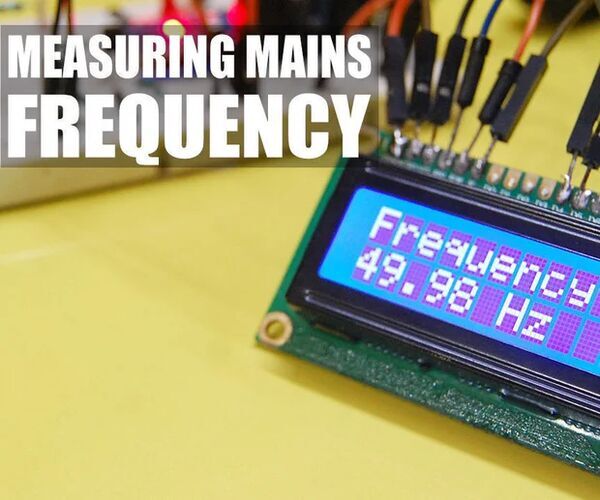
Measure Mains Frequency Using Arduino
"On 3rd April, Prime Minister of India, Shri. Narendra Modi had appealed to Indians to turn off their lights and light a lamp (Diya) at 9:00 pm on 5th April to mark India's fight against Corona Virus. Just after the announcement, there was big chaos on social media saying that this would result in a complete blackout due to failure of the electric grid. I, being an electrical engineering student, wanted to see the effect of a sudden reduction of load on the electric grid. One of the parameters which gets affected is Frequency. So, I decided to make a device to measure the frequency of voltage from a power outlet in my house." [...]
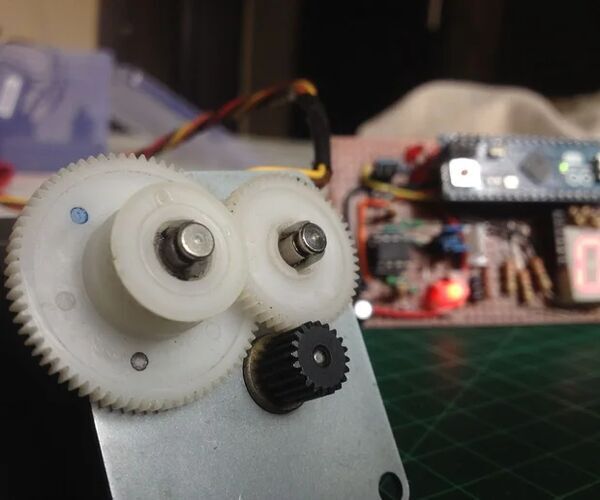
Use a Stepper Motor As a Rotary Encoder
"Rotary encoders are great for use in microcontroller projects as an input device but their performance is not very smooth and satisfactory. Also, having a lot of spare stepper motors around, I decided to give them a purpose. So if have some stepper motors lying around and want to make something, get the supplies and let's get started! For this project, you will need: A stepper motor(Unipolar or bipolar). An LM358P op-amp chip. A 1k Ohm resistor." [...]
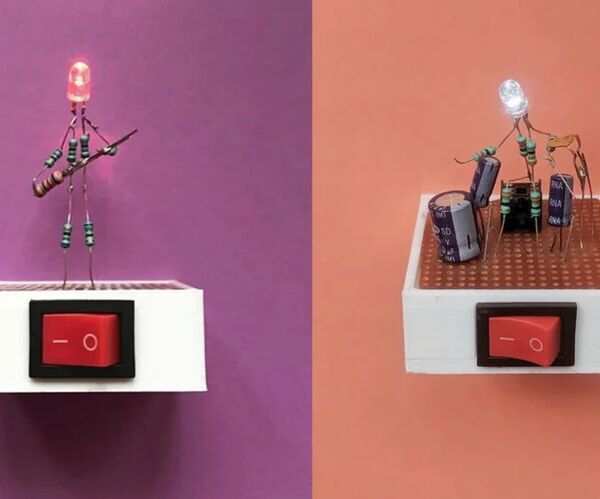
LED Sculpture: Let's Build an LED Man!
"The words LED and sculpture seem oddly placed together, dont they. Well, what if you could learn about basic electronic elements, and at the same time, channel your inner creativity by making sculptures? Paper Crane Lab teaches you how to do this. Read further to find out how to do it! If you would prefer a video tutorial of this, you can find it here. Ages: 8+ (parental guidance required) Activity duration: 1-1.5h Supplies: Soldering iron and solder wire Helping hands stand (optional) 3V battery 3V battery holder LED of your choice of colour 6 resistors (4 of them between 1-10 ohms, and the other two of any value) Electrical wire Wire stripper and cutter Small PCB board Switch" [...]
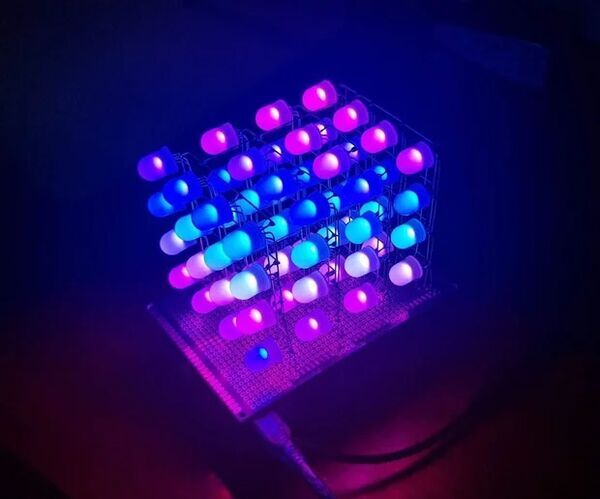
RGB LED CUBE 4x4x4
"Today I'll share how to make an 4x4x4 led cube which is built from Arduino Nano, RGB LEDs 10mm - common anode and double side prototype PCB. Let get started. Main parts include: 01pcs x Arduino NANO. 64pcs x RGB LED, 10mm, Common Anode. 06pcs x Power Logic 8-Bit Shift Register TPIC6B595N. 04pcs x Transistor A1013." [...]
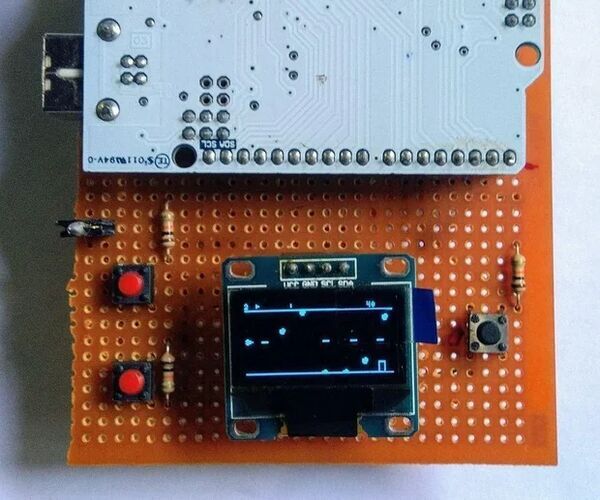
Space Trash Game Using Arduino and OLED Display
"Dear friends, Welcome to Pi BOTS MakerHub. Today we are going to make a Game using Arduino and OLED Display. I recommend using the 128x64 pixels OLED display with I2C or SPI Communication, and a smaller Arduino like PRO Mini. But I use Arduino UNO since Components are not available for purchase due to COVID19. We could make this game console using ATtiny85 also. Supplies: Hardware components Arduino UNO & Genuino UNO (Or any other Arduino Compatible Microcontroller Like Attiny85 is enough.)" [...]
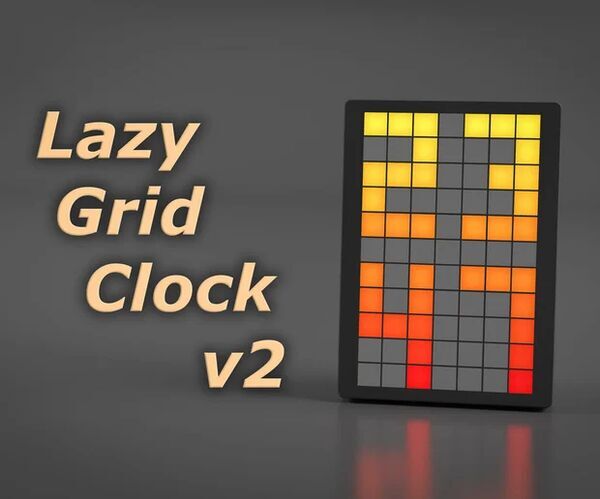
Lazy Grid Clock V2
"Lazy Grid Clock v2 Welcome to LGCv2, a 7x11 led matrix using a single LED strip. The idea behind this thing was to avoid soldering multiple led strips like in a classic matrix. For this to work there's 6 leds "wasted" but it makes building the grid much faster. Basically this is the same as my previous Lazy Grid Clock - it's now finally updated to provide an easier build and use less materials, like screws. As there are some remixes/modifications out there I kept orientation/start point of the grid, so the sketches can be used on LGCv1 and v2. The Arduino sketch is based on the S7ripClock." [...]

Temperature Measuring Automatic & Voice Inform
"Recent day, whole world is struggling with virus Covid19. First checking for effected people (or suspect to be effected) is measuring body temperature. So this project is made to model that can measure body temperature automatically and inform by voice. Let's start! Component for the project: 1. Arduino UNO 2." [...]
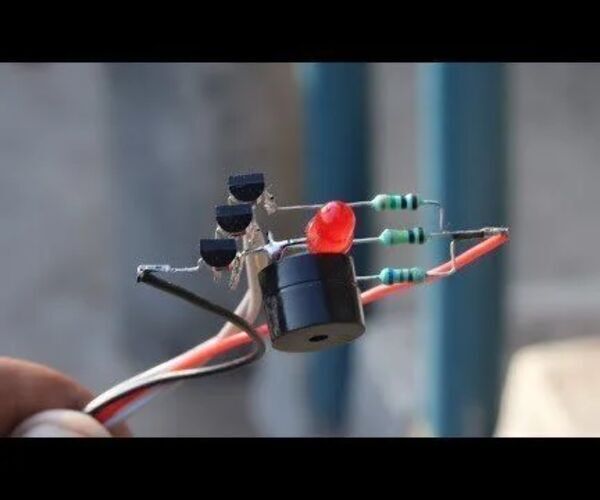
Non Contact AC Voltage Detector Circuit Diagram
"AC Voltage Identifier Circuit is a primary circuit based totally NPN transistors like BC747, BC548. The circuit is dependent on 3 distinct stages. After that, the frail sign was given solid and This circuit can run the Drove just as the bell. Here is a speedy article with a Video instructional workout for this Venture. This must likewise be feasible with CD4017 Interpret counter Yet for an easier arrangement, The transistor Technique is ideal. How the Circuit Functions?" [...]

Planetary Gear Clock
"(Old) mechanical clockworks are incredibly interesting and pleasing to watch, but are unfortunately almost impossible to build yourself. Mechanical clocks also lack the carelessness of the precise digital technology available today. This Instructable shows you a way to combine the best of both worlds; by driving mechanical clock hands through a planetary gearbox with a stepper motor and an Arduino! Supplies: General components: 5mm wood and acrylic sheet M5 bolts (countersunk), washers and nuts PCB standoffs M3 screws for the stepper motor Electrical components: Stepper driver (i used the L293d) Any type of Arduino Real Time Clock (i used the DS3231) Hall effect sensor (i used the A3144) 5mm Neodium magnet Buttons for user input 10K resistor 100uf 25V capacitor DC jack 5V 2A DC power supply Battery for the RTC (cr2032 in my case) Mechanical components: Any type of 1.8 degree/step stepper motor with 5mm axle GT2 400mm timing belt GT2 60 tooth 5mm axle pulley GT2 20 tooth 5mm axle pulley 5x16x5 mm bearing (3x) 5x16x5 mm flanged bearing (2x) M5x50 threaded rod" [...]
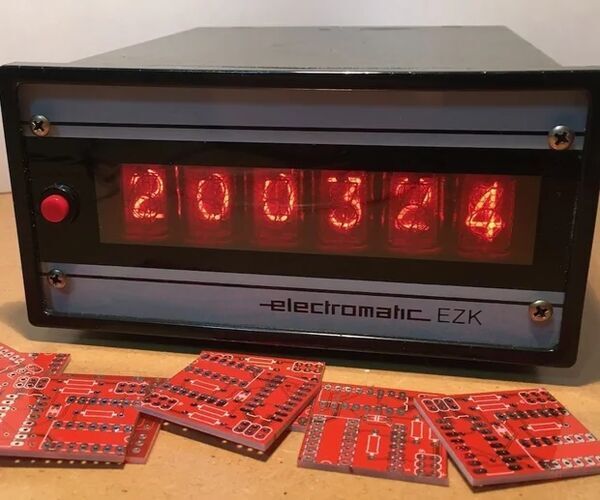
Versatile I/O Extender PCB to Control Many Nixie Tubes With I2C
"Currently there is a lot of interest in bringing vintage nixie tubes to life. Lot's of nixie tube clock kits are available on the market. There appeared to be even a lively trade on old stock of russian nixie tubes. Also here on Instructables there are tons of projects on nixie tubes (https://www.instructables.com/howto/nixie/). This Instructable describes a driver for nixie tubes with I/O extenders, controllable by I2C, using a versatile PCB developed specifically for this purpose. The microcontroller and its software are not part of this Instructable." [...]
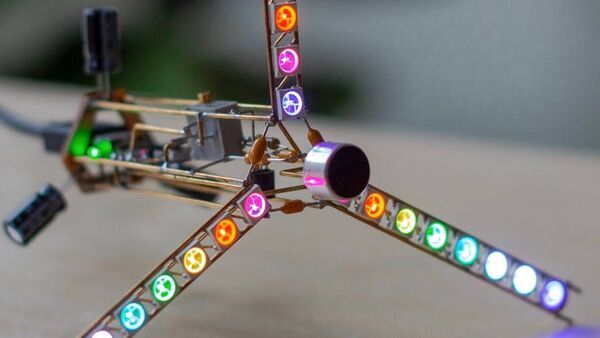
This Spectrum Analyzer Sputnik Shines a Light on the Sounds Around
"Looking like something straight out of a sci-fi film, this steampunk Sputnik sculpture shines out in response to the sound around it. Mohit Bhoite is back again, and this time with a "stellar" example of his circuit crafting skills, in the form of a satellite-inspired spectrum analyzer sculpture. Looking like something straight out of a sci-fi film, this steampunk Sputnik has something of a Dark Side of the Moon vibe as pictured above, and perhaps that's in part down to the dazzling light show it is capable of putting out. Mohit Bhoite is back again, and this time with a "stellar" example of his circuit crafting skills, in the form of a satellite-inspired spectrum analyzer sculpture. Looking like something straight out of a sci-fi film, this steampunk Sputnik has something of a Dark Side of the Moon vibe as pictured above, and perhaps that's in part down to the dazzling light show it is capable of putting out. Not content with pre-programmed pixel patterns, Bhoite has taken an interesting direction, in giving this sculpture the ability to listen to the noise around it, and respond in its own unique way." [...]
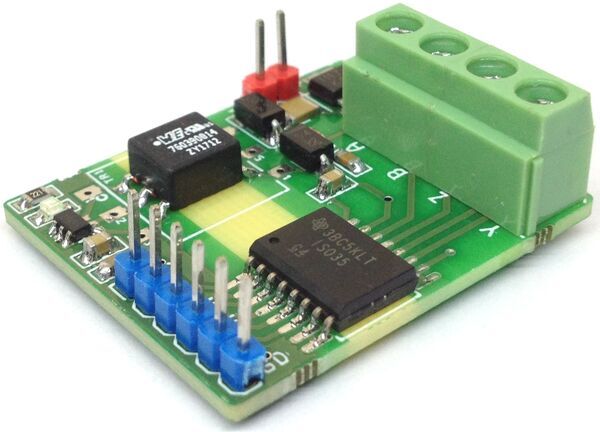
Isolated Full-Duplex RS-485 Transceivers
"This module is an isolated full-duplex differential line driver and receiver for TIA/EIA RS485/RS422 applications. The module is ideal for long transmission lines because the ground loop is broken to allow for a much larger common-mode voltage range. The symmetrical barrier of the device is tested to provide isolation of 2500Vrms between bus line Trans-receiver and the logic-level interface. The circuit works with a single supply 3.3V input. SN6505 Chip and Wurth Elekronics 760390015 transformer help to generate 5V DC to power up isolated circuitry. The module has been designed using ISO35 IC which is an isolated full-duplex RS485 trans-receiver, SN6505 IC used to form isolated DC-DC converter to power up the bus side of isolated circuitry of ISO35, LM1117-5V IC regulates the output of DC-DC converter and provides 5V DC." [...]
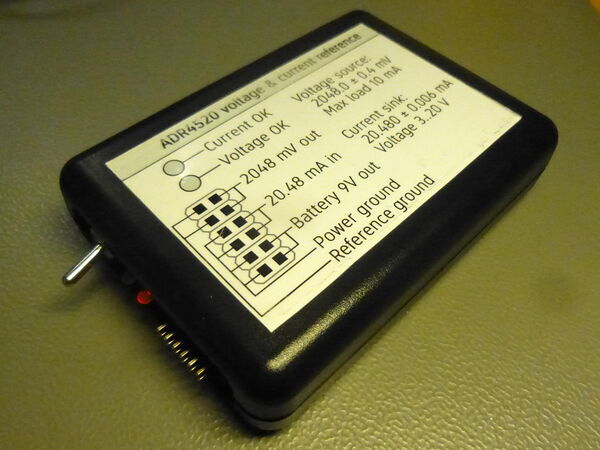
Voltage and current reference
"When developing a data acquisition system, I ran into a need of having fairly accurate current reference to compare against, 0.1% accuracy or better. This is not a particularly high standard, but unable to find a suitable device in my price range, I chose to design my own. EBay has plenty of high-accuracy voltage references available, but not many current references. There is also DMMCheck, but it is a bit too expensive for me. Three approaches to high-accuracy references The gold standard when it comes to calibration references is tying them to some reproducible physical behavior. For current references, that would be a Kibble balance and could achieve accuracy on the level of 0.1 ppm (i.e." [...]
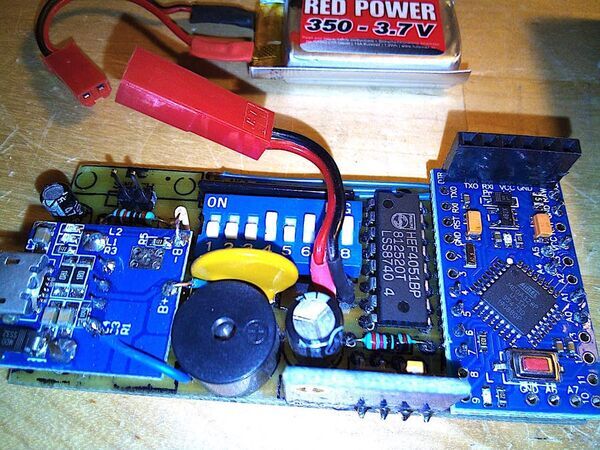
Acoustic Variometer (Ultra Sensible Barometer)
"As a free flying paragliding pilot, I have finally built my own simple but effective instrument that plays beep-beep during climb and so on. It is an instrument used by pilots during flights (sailplane, paraglider, hanglider, balloon, etc.) to help finding the core of the thermals and climb the air more and better. Brief description: It is a very sensitive barometer that emits sounds when climb (going up) and also when sinking (going down). Sounds are simple beep-beep, every second, or two per second or more during climb (more climb rate = higher frequency beeps): it is so sensible that it starts beeping just after a few centimeters (!) per second; you may try slowly lifting your arm holding in the hand the Vario to obtain the sound." [...]
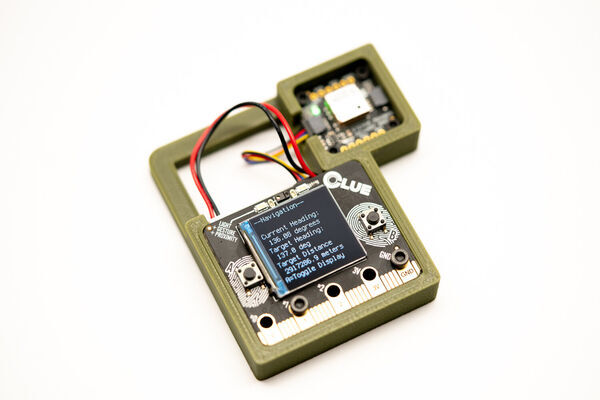
Find Your Way Home With This Circuit Python GPS Locator
"When GPS was first released to consumers, it wasn’t even in the hands or understanding of most people. Early on it was used for pretty unique and esoteric stuff, and in the age before ultra-connected devices that use common smartphone apps, there were GPS receivers. They pretty much just displayed current coordinates including latitude, longitude, and altitude- not much else. There’s a great set of old devices over at retro-gps.info. The old units are big, heavy, slow, and use a ton of power for what they do. Modern GPS units are light, small, cheap, and use very little power." [...]
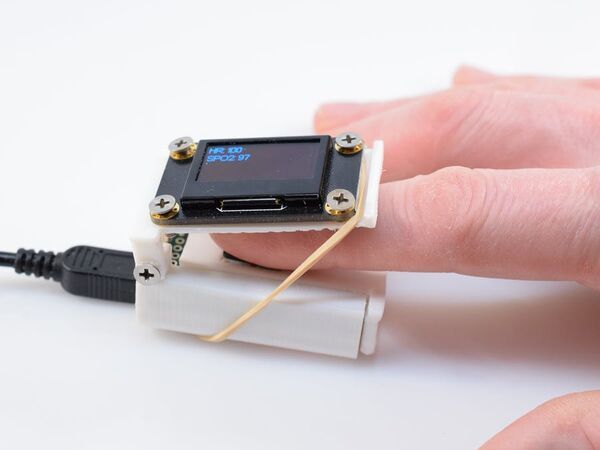
Open Source Pulse Oximeter for COVID-19
"An easily constructed USB-powered pulse oximeter device that can be built for around $25 and features an OLED display. COVID-19 is a disease caused by the SARS-CoV-2 virus that primarily attacks a person's respiratory system. Some milder symptoms can include fever, aches, and chills, but it can also lead to more serious conditions such as pneumonia. A person who has pneumonia or even slight shortness of breath might not know when to go to a hospital, especially as they start to get even more overwhelmed. This is why I created this open source pulse oximeter, which can assist in getting people the help they need and get accurate information about their current condition. " [...]

Light-Up PCB Necklace V2
"If you like making jewelry and have some experience using the Bantam Tools Desktop PCB Milling Machine, this is a great project for you! It offers a wonderful way to get creative and artistic with double-sided machining. The necklace has four LEDs on the back of the pendant that provide a beautiful glow around the outline of the pendant and highlight the pattern on the front of the necklace by illuminating the etched traces. This tutorial gives you two design options: a blank, solid copper front or a bird feather pattern on the front. We also made a bat version of this necklace! Everything is the same, except the shape of the board, so the instructions here apply to the bat as well as the hummingbird." [...]
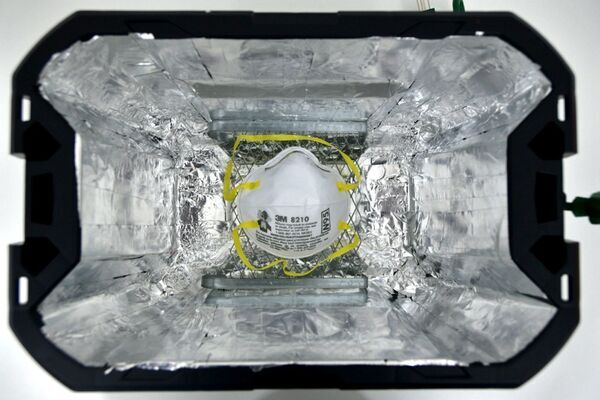
Build a DIY UV-C Sterilization Cabinet to Fight Covid-19
"As thousands of essential workers bravely continue to do their jobs despite limited access to personal protective equipment, the need to sterilize their PPE, especially their masks, increases daily. Contained UV-C irradiation is an effective way to sterilize non-porous items such as N95 masks, phones, keys, and more. While some front-line health care workers have access to professional UV irradiation cabinets, many other essential workers who interact with the public every day do not. Since many UV sterilization products are sold out, DIY irradiation may be one of the few options left for many people during this coronavirus pandemic. However, most DIY UV irradiation cabinets require hard-to-find parts, engineering know-how, and/or specialized tools. YouVee is a DIY irradiation cabinet that can be made at home in under 1 hour using common tools and simple components, for about 50 bucks — no tech skills required." [...]

DIY Alarm Bike Lock (Shock Activated)
"In this project I will be showing you how to create a simple shock activated alarm bike lock. Like the name implies, it does create an alarm sound when your bike is being moved around with permission. Along the way we will learn a bit about piezoelectric discs, amplifiers and a simple logic circuit. Let's get started! " [...]
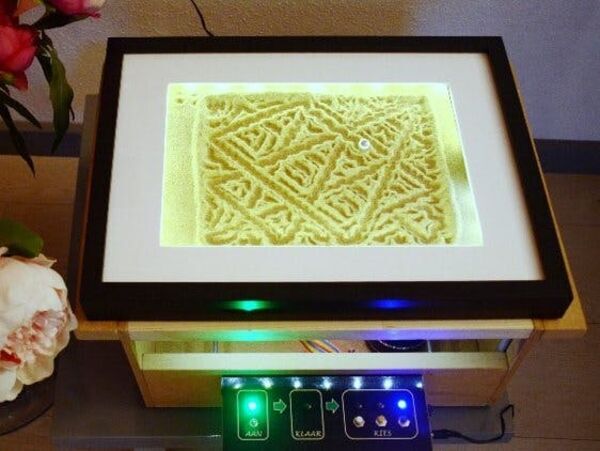
Sand Art Display
"A Japanese zen garden built into a glass-covered picture frame. Imagine a Japanese zen garden built into a glass-covered picture frame. Below the frame are electronics and robotics, creating geometric patterns and images in the sand. The effect is enchanting and magical, it is really zen-like to see ever-changing patterns and images slowly appear in the sand. The Sand Art Display is a modern version of this traditional zen sand garden. It is a drawing machine that creates mandala-like patterns in the sand." [...]

Irrigation Motor Control and Monitoring system
"Controlling and monitoring the pump which is used to irrigate the agricultural land. Irrigation motor control and monitoring. we are using a Bolt IoT device in this project and soil moisture sensor, this project is used to sense or measure the moisture content in the soil. the soil moisture sensor is a sensor which varies the value when it contacts the moisture. basically it is a resistor that works on moisture condition. when the moisture is more then the value of resistance will decrease and when the moisture is less then the resistance value is more." [...]
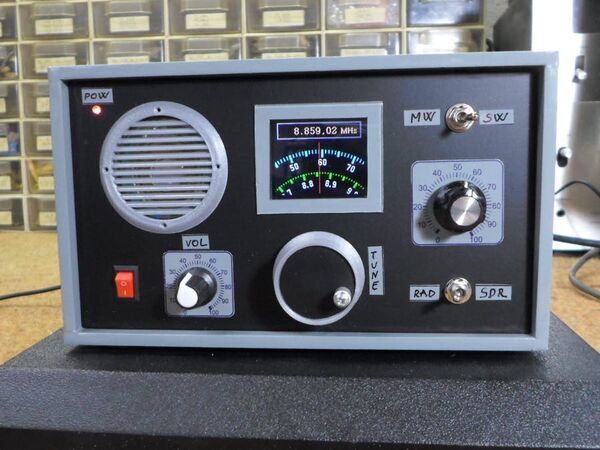
DIY SW, MW, SDR Radio with ESP32 and Si5351
"Sensitive retro look radio capable of receiving signals from middle wave and short wave band. This radio receiver is capable of receiving all MW and SW bandwidth, and can also operate as an SDR receiver, so with the help of PC and appropriate software we can decode many different types of signals. At the input we start with a potentiometer of 1 k ohm, it is the RF attenuator. The next circuit is the preselector, switchable to the MW and SW ranges. Tuning of the preselector is done with a potentiometer. The tuning voltage is stabilized by 4 LEDs but of course you can also use a 6.8 V or 8.2 V zener diode." [...]

Decoding PWM Using an FPGA
"Using a standard RC transmitter (HobbyKing HK-T6A) you will learn how to create and test Verilog to decode 6 channels of PWM. The transmitter outputs 6 PWM channels at 50Hz with each channel ranging from 1000us to 2000us. There are many waveform examples that can be found on the web. Here is a trace of all 6 channels from the transmitter Decoding PWM A 1.0MHz clock will count the number of ticks present in "on" and "off" pulse and report the value in microseconds. If the "on" time is bigger than 2600us an error is reported, this maybe due to bad wiring or PWM line is locked high. Also, the same logic will be used to detect if the line is locked low, for example, if the transmitter is turned off, the PWM value is updated with 0 and error condition." [...]

ESP-01 Breadboard Adaptor
"A breadboard adaptor so you can prototype your ESP-01 If you ever tried to tinker around the ESP8266-01 you've probably realised you can't plug it in directly on your breadboardThen you also realized it doesn't run on 5V, so you need to convert the voltage down to 3.3V.And afterwards you realized your ESP doesn't boot up because of initial current spike.Well this board solves all of these problems. Here are its specs: 3.3V Regulator SPX3819 40uF Capacitance on Power Lines Power LED GPIO D2 LED RST Switch Boot Switch" [...]

ArduTester Millenium, the ultimate UNO & MEGA Versions
"With modern I2C Protocol for the LCD, minimizing the wiring. A Basic Version with the Arduino UNO and a feature rich Version with the MEGA. Since Publication of the Ardutester V1.13 ( with limited number of Display Interfaces, mainly the popular 4 Bit Parallel 1602 LCD featuring 2 lines by 16 characters, HD44780 controller, was supported. ). Over time, I was adding other displays and modernizing the Software drivers by using the Arduino wire Library for the High Speed native I2C, which brings the performance needed for a responsive graphical OLED Display. Because the Ressources needed for the graphic version of the ArduTester, a MEGA is needed when a Graphic Display is choosen." [...]

Xling
"A tamagotchi-like toy with an OLED display and Li-Po battery. This is a little tamagotchi-like toy I've created for my wife. I used to think that this is how a modern Tamagotchi could look like initially. However, it can also be used as a battery-powered DIY platform to experiment with FreeRTOS and graphics. Specifications - 35x47mm board - Monochrome OLED 128x64px - Low energy consumption (~20mA @ active, 0.75mA @ sleep) - Hand-soldering friendly (TQFP-44 0.8mm pitch, smallest is 0603) - 3D-printable case - Open Source Hardware/Firmware Hardware - ATmega1284P 8-bit AVR MCU with 128 KiB flash and 16 KiB SRAM - SH1106G display controller - MCP73831 charge controller - AP3401 DC-DC buck converter - 400mAh 3.7V Li-Po battery (~26h @ active, ~30 days @ sleep) - Load-sharing circuit (can be powered by USB or battery, like a smartphone) - KiCad 5.1.0 project for schematic and board designs - Released under CERN-OHL-W v2 (Rev. 4) and CC-BY-SA (before Rev." [...]
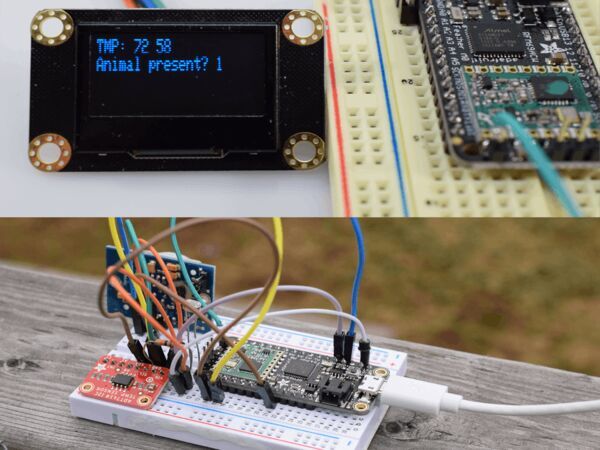
Backyard Weather Station with Packet Radios
"Use two 915MHz radios to send/receive current environmental information and display it in real-time up to 350 meters away! Environmental Monitoring It's almost gardening season, which means monitoring your plant beds for adequate sunlight, warmth, and pesky critters is more necessary than ever. But, there's an issue; most IoT gardens rely on WiFi, which can be a large problem if your garden happens to be more than a couple hundred feet away. A potential solution is logging the data and reading it back, but that can't occur in real-time, and using a cellular network costs a lot of money. This project aims to solve that issue by utilizing a pair of Adafruit M0 Feathers with integrated RFM69 radio modules to provide real-time monitoring across a large distance. " [...]

NerfOrNothing
"A smart foam football that tracks your throws My team and I cut a Nerf football in half, stuck a WiFi-enabled microcontroller and some accelerometers inside, and wrote some inertial-navigation code to track throw distance and spin rate. This was our final project for Physics 4AL: Mechanics Laboratory. We started the project by slicing the body of a Nerf Vortex foam football in half with a box-cutter. We chose this particular football because it was cheap, stable during flight (due to the dart-shaped tail) and easy to mount electronics in. The ball had three whistles mounted along its perimeter; we removed one to make room for the electronics. We had two goals: measure the acceleration of the ball during the throw (which is used to calculated distance thrown) and measure the centripetal acceleration of a point on the ball (which is used to calculate angular velocity)." [...]
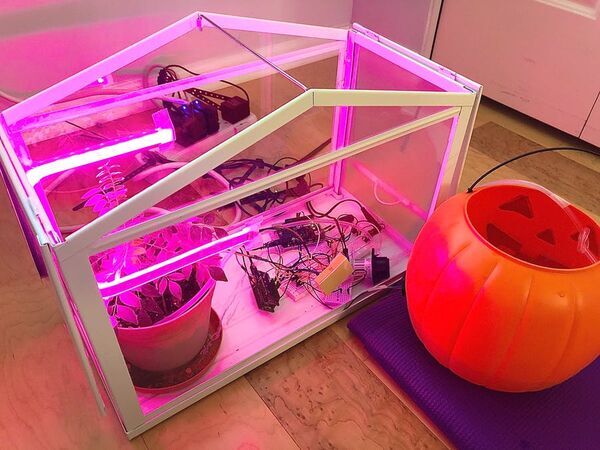
Self Sufficient Automated Greenhouse
"This greenhouse only needs quarterly maintenance, water refills, and heat maintenance to grow high-quality plants in the optimal conditions. Story Sometimes, taking care of plants is a big hassle. You need to give them just the right amount of sunlight, water them constantly, and keep them at the right heat. Well, work hard no more! With this greenhouse, you only have to perform three easy things. (1), fill the water tank every so often, (2), change the heat level of the greenhouse." [...]
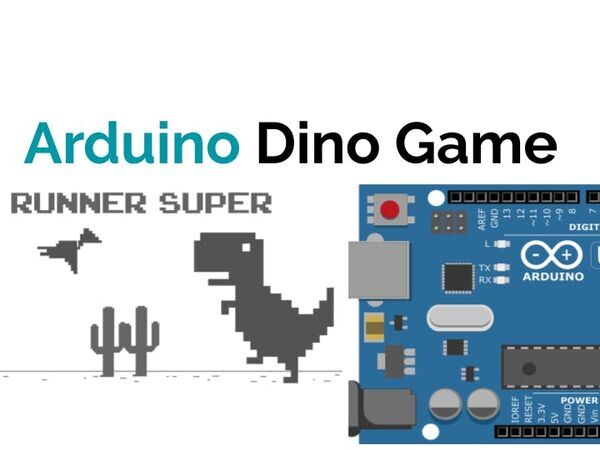
Automated Dino game using arduino
"Automated T-Rex player using arduino and python. " [...]
That's all Folks!



